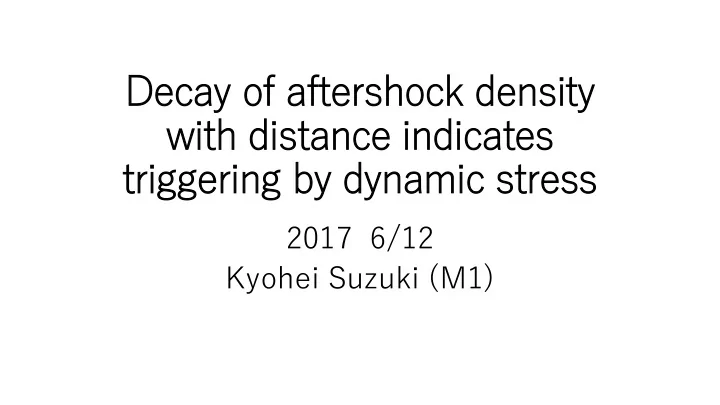

Decay of aftershock density with distance indicates triggering by dynamic stress 2017 6/12 Kyohei Suzuki (M1)
Introduction • Previous studies : Static stress changes trigger aftershocks . • Recently studies : dynamic stresses changes may also trigger them ( seismic shaking ). • aftershock density decays with distance from the mainshock have found a range of functions . (power low)
Analyze(Data) • 1984 – 2002 relocated Southern California catalogue. (Shearer er al., 2005) • M 2 – 6 mainshocks divided • M 2 – 4 mainshocks and M ≥ 2 aftershocks • M 5 – 6 mainshocks and M ≥ 3 aftershocks
Mainshock and aftershock selection • Earthquakes are used as mainshocks if they are separated from larger earthquakes by at least 100 km or by 𝑢 1 days if the larger earthquake comes first, and 𝑢 2 days if it comes after. • t is the time after the mainshock for which we use aftershock data 𝑢 1 ≪ 𝑢 < 𝑢 2
We can see decays with distance from the mainshock.
Result ( M 2 – 4 mainshocks ) • Point sources • From 0.2 to 50 km, the data are well fitted by 𝜍 (r)=c 𝑠 −𝑜 (1) (within 5 min) c : constant 𝑜 = 1.37 ± 0.1 𝑔𝑝𝑠 3 ≤ 𝑁 < 4 𝑜 = 1.35 ± 0.12 𝑔𝑝𝑠 2 ≤ 𝑁 < 3
• We also check the applicability of M 2-3 M 3-4 equation (1) to longer times • Within 30 minutes • From 0.2 to 16 km, the data are fitted .
Result ( M 5 – 6 mainshocks ) • Harvard CMT focal mechanism solution • Estimate fault plane • recover an inverse power law from 0.2 km to 12 km from the closest point on the fault plane • 𝑜 = 1.34 ± 0.25 within 2 days
• The consistent aftershock decay relationship observed from distances of 0.2 km to 50 km (from within 0.05 fault lengths of M 5 mainshocks to over 100 fault lengths of M 2 – 3 mainshocks ) • Static stresses decay rapidly. • Triggering by static stress in the near field and dynamic stress in the far field would require a discontinuity in the aftershock decay. • Only uniform triggering by dynamic stress matches the observation of a single, consistent decay that traverses a wide range of distances
We also find more model-dependent evidence that the number of aftershocks triggered varies linearly with dynamic stress change amplitude.
• B(r) is the background seismicity per kilometre per unit time as a function of distance from the mainshock. • This function describes points randomly scattered on a structure with effective dimension D.
be separated into geometric and physical terms be substituted for the geometric term
• We find a better fit with D = 1 than with D = 2 or 3; that is, the linear density is independent of distance . • earthquakes concentrate on planar faults, whose width is also limited by the seismogenic depth. At distances longer than ,10 – 20 km, effective D for earthquakes randomly scattered on a fault tends towards 1.
In summary • the decay of aftershock linear density with distance from M 2 – 6 mainshocks is well fitted by an inverse power law. • If the linear density of faults is independent of distance , then the data indicate that the probability of triggering an aftershock is directly proportional to the amplitude of seismic shaking. • The similarity of aftershock decay from distances of 0.05 to over 100 fault lengths implies a single physical triggering mechanism, and dynamic stress change is the only plausible agent over most of this range.
Recommend
More recommend